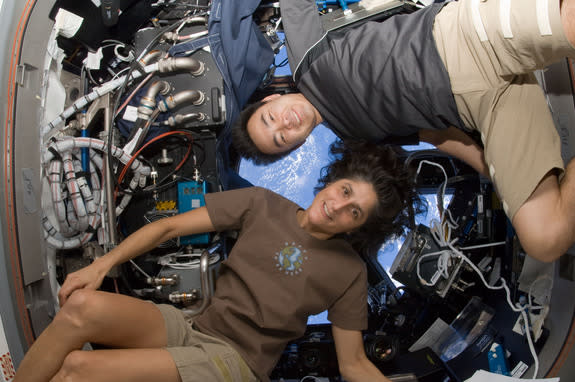 Science and Weather
Science and WeatherIn space no one can see you cry

Imagine you're walking along the street, when suddenly the wind kicks up and you get a fleck of dust in your eye. Aah! Immediately, there's stinging pain! Tears well up and run down your face as your body tries valiantly to flush the offender out! You dig a knuckle into the corner of your eye to give them a little help and you're free! You wipe the tears from your face and continue on your way.
Not so fast, though... suddenly, instead of walking down the street, you're in space! You're floating far above the Earth's surface, safely cocooned against the airlessness and radiation in a life-preserving space suit, staring down at the majesty of our planet as it whizzes by underneath you! You've already been out here for a few hours and completing the critical repairs on the International Space Station will take a few hours more.
There's no dust or wind in your suit, but just out of the corner of your eye you see that a flake of the anti-fogging solution (dish-soap) from the inside of your helmet visor has come free and is floating towards your eye! Before you can even blink you are now trapped in the hell of a stinging, watering eye, with no way to rub it, because taking off your glove and helmet would mean instant* death, and your tears are no help at all either, and are, in fact, making things worse!
[ Related: NASA turns astronaut trash into space radiation shield ]
This is because in the microgravity of low-Earth orbiting spacecraft, tears do not fall. When you were standing on the street, the unfortunate victim of a foul wind, the force of gravity was strong enough to overcome the surface tension and adhesive force of the tears, and they rolled off your eye and down your cheek. In microgravity, as the name implies, gravity is very weak — much weaker than the other forces exerted on the tears — so the tears stay stuck to your eye, essentially trapping the irritating offender there.
Now, when this actually happened to astronaut Andrew Feustel, back in 2011, he managed to hunch down in his suit, and rub his eye against the small block of foam in his helmet that is usually used to block the nose when making a suit pressure readjustment. That saved him from having to retreat back into the station, and thus avoided a delay in the work that they were doing.
Typically when we think of the physical difficulties of living in the 'weightlessness' of space, it's stuff like muscle atrophy or bone-density loss or radiation exposure that come to the forefront of our minds, but it's examples like this that show how even small things make living in space a very different experience for us.
[ Related: Strange But True: Astronauts Get Taller in Space ]
And while we're talking about the 'small things', check out this video from Canadian astronaut Chris Hadfield — who has been earning some celebrity status on Twitter since his arrival on the ISS — as he demonstrates something else most of us probably don't consider about being in space:
(*Alright, I was being dramatic. It wouldn't be instant death, but more like slow asphyxiation, which is still be pretty bad.)


